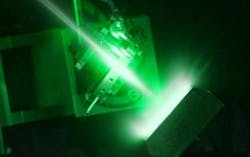The absorption of petawatt-level laser pulses by solid matter is a phenomenon that has been the subject of theoretical and experimental study for more than two decades. Now, scientists at Lawrence Livermore National Laboratory (LLNL; Livermore, CA) and Rice University (Houston, TX) have defined a set of theoretical boundaries for the absorption of petawatt laser light.1
Irradiation of solids by petawatt laser light can create extreme states of matter with temperatures exceeding 1 x 106 °C and pressures exceeding 1 x 109Earth atmospheres. These high-energy-density conditions are driven by violent, highly nonlinear optical-absorption processes, which can accelerate electrons from rest to 99.9% of the speed of light over just a few microns. Suitably harnessed, these conditions open the way to advanced scientific applications such as compact radiation sources, laser fusion, laboratory astrophysics, ultrafast imaging systems, and intense high-harmonic generation (HHG) that can enable attosecond spectroscopy.
"The potential for breakthrough scientific applications is very high," says Matthew Levy, lead author and Lawrence Scholar in the Physics Division at LLNL. "But because the interaction is so nonlinear, a key outstanding problem has been predicting the amount of light absorbed. The new analysis that we have developed reveals the theoretical upper and lower limits."
The analysis itself is centered at the laser/matter interface, where the laser light decays into an evanescent wave at the surface of the (optically thick) target; a relativistic kinematic model determines the connection between the decaying laser pulse and the particles it excites.
The LLNL researchers showed close agreement between the absorption bounds and more than 75 experimental data points and simulation results that cover multiple laser wavelengths, intensities, polarizations and target materials, helping to confirm the theory. "These are natural bounds which emerge from our analysis," Levy notes. "Defining them leads to a greater understanding of petawatt laser-solid physics today and drives alternative research paths where the desired results lie beyond those bounds."
Novel target structures needed
The results show that petawatt-scale nonlinear-absorption mechanisms forbid high absorption at lower laser powers, and low absorption at higher laser powers. As a result, scientists will have to develop new materials to tailor absorption (for example, to increase absorption at lower powers), such as low-density or multilayered structures.
Because the majority of experiments today use solid targets, these new findings should significantly impact the development of future petawatt-laser applications.
REFERENCE:
1. Matthew C. Levy et al., Nature Communications (2014); doi: 10.1038/ncomms5149

